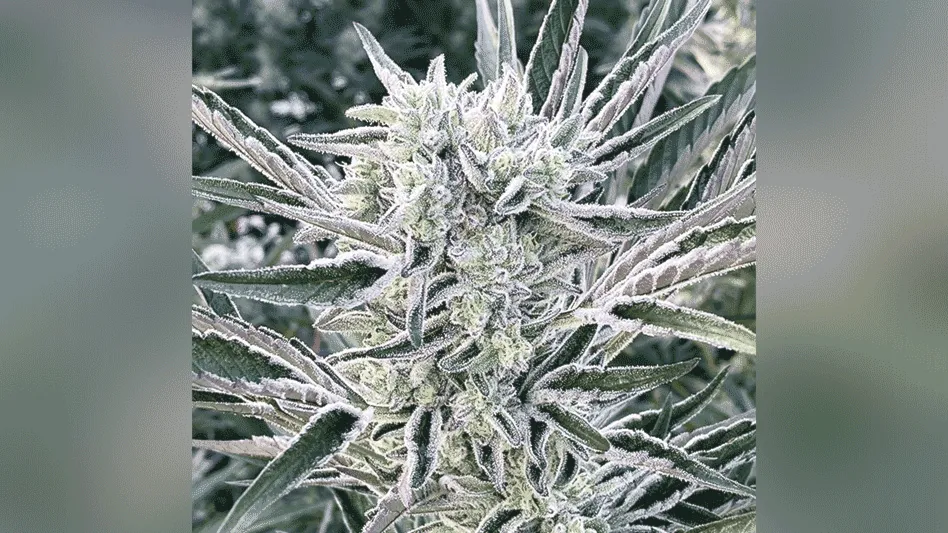
Photo by Sjoerd Broeks
Cultivar Details:
Plant Physiology: Apple Tartz has a squat, bushy structure with relatively sparse leaves that are medium-sized, dark and wide, demonstrating traits of the Apple Fritter parent. Quick to trigger to flower, Apple Tartz does not stretch much, and due to its compact nature, it can be planted at a higher plant density when row cropping. Apple Tartz leans more toward its Fritter lineage with its vigorous and sturdy structure and needs very little trellis support during flower.
Average Yield: Apple Tartz has average yields for a commercially viable cultivar. Crop spacing density outdoors or under natural photoperiod can be increased by 33% due to Apple Tartz triggering into flower quite quickly. For row cropping systems, Apple Tartz does best when left unpruned if planted after mid-July. Apple Tartz can be a fantastic early finishing crop for any farm. Yields of 45 grams per square foot or more can be expected for greenhouse and indoor growers without the need for advanced crop steering techniques. When extracted from fresh frozen flower, Apple Tartz yields fairly high at 4% to 5% finished rosin.
Flowering Time: Recommended flowering time for indoor and light-deprivation greenhouses is 52 to 60 days. Outdoors, full-term harvests can be expected in late September to early October.
Environmental Conditions: Apple Tartz is versatile and performs well in different climates and environmental settings. Due to its fast maturation time, it is advisable to feed plants aggressively throughout their vegetative growth cycle to get the plants as large as possible before they trigger into flower.
Recommended Input Conditions: Apple Tartz thrives in crop systems tested so far and checks all the boxes for most growers. It is one of the cultivars that is grown equally for flower and for extract. Generally, Apple Tartz is a medium to heavy feeder, but because it triggers into flower quickly, fertilizer management and irrigation strategies need to be slightly tweaked in line with the crop’s physiological stage. Usually by 35 days in flower, the fertilizer input schedule would be the equivalent of day 42 for most 63-day crops.
Integrated Pest Management (IPM) Notes: A mild susceptibility to botrytis has been reported in challenging coastal conditions. Careful crop spacing, preventative IPM measures and timely harvesting will mitigate serious issues in more challenging environments. Generally, Apple Tartz matures early enough to avoid most of the diseases that are prevalent once the rains start.
Cannabinoid Profile: Apple Tartz consistently tests between 26% and 32% THCA. There are small amounts of CBG present at 0.7%.
Terpene Profile: Depending on phenotypical expression, Apple Tartz can range from candy gas to sour apple tones. High in linalool, limonene, caryophyllene and myrcene, Apple Tartz has an interesting range of effects reported by end consumers.
Quality of High: Fairly potent but soothing due to the nature of its terpenes, Apple Tartz has been described as having a perfect mixture of the Apple Fritter’s calming potency and the characteristic lively high and sweet taste of Runtz.

Explore the September/October 2023 Issue
Check out more from this issue and find you next story to read.
Latest from Cannabis Business Times
- Cannabis Industry Reacts to Biden’s Rescheduling Announcement
- As Predicted, 4/20 Sales Surged During Cannabis Industry Holiday Weekend
- DEA 2024 Report Focuses on THC Potency, Organized Crime, Youth Edible Consumption
- Nature's Miracle, Agrify Sign Definitive Merger Agreement
- 5 Things to Confirm When Signing a Cannabis Facility Construction Agreement
- Ziel Partners With Portocanna, Receives 1st EU GMP Certification for Microbial Control Technology in Cannabis
- White House Moves to Reschedule Cannabis in ‘Monumental’ Decision, Biden Says
- SOMAÍ Group, and Its Subsidiary, RPK Biopharma Expand Cookies Partnership to Include Europe and the UK





